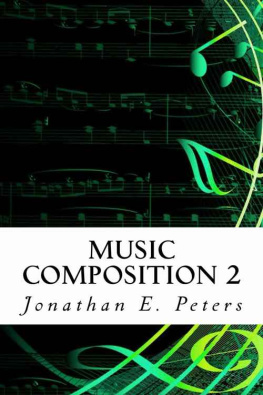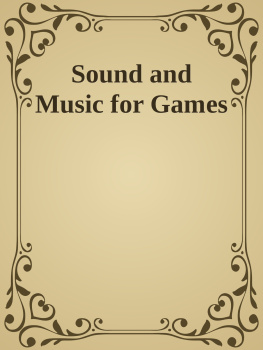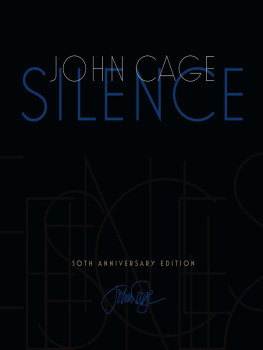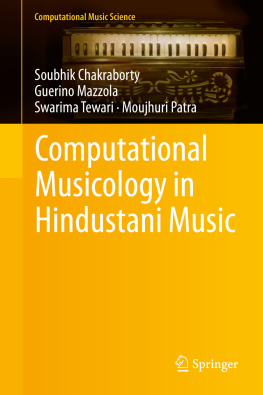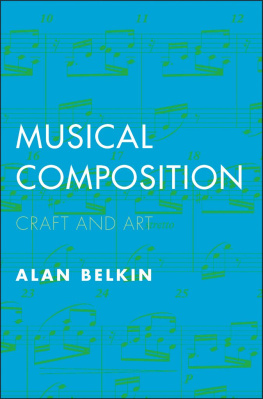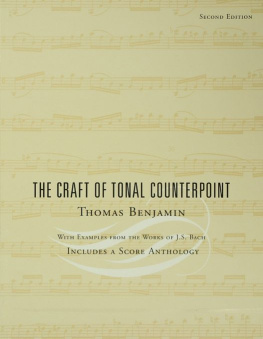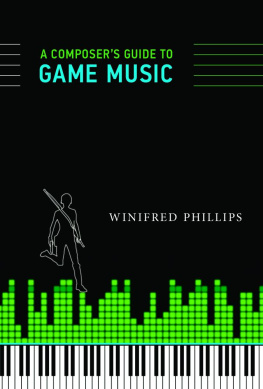1. Rhythmic Transcription
BEFORE WE BEGIN
This course is divided into two portions. The first portionis devoted entirely to the study of rhythmic composition. The second portion isdevoted entirely to the study of melodic composition. The second book in thisseries, Music Composition 2, will deal with harmonic composition andcompositional form.
To get free life-time access to all of the audio samplesfor the diagrams in this book and also quizzes for each lesson please go to:
https://www.udemy.com/musiccomposition1companion
Click on Enter Password and enter: 2v67dh3
Click on Start Learning Now.
The next window will ask you to sign up for a Udemyaccount. Enter your name, e-mail address, and create a password for youraccount.
Thats it!
WHY COMPOSE?
It is a common misconception that in order to be able tocompose music one must be born with the gift for it. Although one cannotteach inspiration or the creative spark, one can supply the tools andknowledge necessary to write music. While its certainly true that not everyonewho attempts to compose music is going to become a Mozart or a Bach, it doesnot follow that unless you can compose on that level you should not evenattempt it. That would be like saying only the Shakespeares of the world shouldwrite words and that no one else should bother picking up pen and paper. Notonly is it possible for anyone to compose music, it is quite vital for everystudent of music to have some experience with music composition.
It is a sad but true fact that most modern music teachersand music courses do not include music composition as part of the studentsmusical education. In the past it was typical for students of music to be ableto compose music. One example is J.S. Bach who trained all of his students tobe composers as well as performers. In fact, if a person did not have somebasic experience with music composition they would not be allowed into hisstudio! This course seeks to fill in some small part this current deficiency inmusic education. The study of music composition is said to complete themusician, since the complete musician is one who has knowledge of musictheory, plays an instrument, and can also compose.
Lets begin then by taking a brief look at some of the mainreasons why learning music composition is important to every musician. Firstand foremost is the deepening of ones understanding of music. To createsomething requires a certain level of understanding of the thing being created.Simply listening to music or playing music involves a much more superficialunderstanding than writing music. Even the person with a firm grasp of musictheory cannot be said to understand music to the same degree as the composer.For example, one may know every type of chord there is to know, but how doesone know what order to place them in to create music? One may know every pitchin a particular major key, but how does one know what order to place thosepitches in to make a beautiful melody? It is simply not enough to knowall the elements and parts of a thing. To have a complete knowledge one mustunderstand how all of the parts work together.
Second, study of music composition can improve onesperformance of music. Although music notation has come a long way over thecenturies, it still remains imperfect. Knowledge of how music is put togetherwill allow the performer to understand the things behind the notes on the pageand those things that are not able to be notated.
Third, some music requires that the performer improvise onthe spot and add to what is notated on the page. Having knowledge of how musicis formed greatly enhances ones ability to improvise music and have theimprovisation sound like music.
Last, the creative process in and of itself brings much joyto ones life. Not to mention the fact that any music composed can then bringjoy to those who hear it or to those who perform it.
GETTINGTHINGS TO PAPER
The first thing that we need to do before we can even beginto start learning how to compose is to learn how to transcribe music.Transcribing is hearing a rhythm, melody, or harmony and being able to notateit (write it down).
Even if you understand all the rules of music composition,if you cannot notate what you hear in your head or what you play on yourinstrument, then you will have a very difficult time composing. Writing down,in musical notation, a rhythm that you hear can be difficult at first and mayseem like a daunting task. Dont give up! The more you practice, the easier itwill become. It is a hill that all beginning composers must climb.
In the past, composers used to write using feather pen and inkon parchment. Next came pencil and paper. It was only a few short years agothat composers began using computers to notate music. Today most composers usenotation software on their computers that allow them to write down their ideasquickly and neatly.
By beginning this course with music transcription this willalso give you a chance to get to know the NotePad software. NotePad is themusic notation program that you will be using in this course to complete mostof your assignments. If you have not already done so, please download andinstall NotePad on your computer before moving forward. When you open theprogram for the first time it will ask you to register. In order to get thefree tech support for the program you must register.
DownloadNotePad at: www.finalemusic.com/NotePad
The following are the four steps you will always take whensetting up a document for the rhythm assignments in the first part of thiscourse. (There will be a different set of steps when setting up a document formelodic and harmonic assignments.)
Step1: Open NotePad (the Document Setup Wizard screen will appear)
Step2: Under Title enter the assignment name (for example Lesson 1 Assignment 1), andunder Composer enter your full name. Then click next.
Step3: In the first column on the left, click on drums. In the second column, clickon snare drum. Click add then click next.
Step4: Thisis where you select the time signature and key signature for your piece. Sincethe first assignments are rhythm assignments you will only need to select atime signature. (NotePad does not allow you to change meter and key within asong.)
You should now see a sheet of music paper on the screen. Youwill notice that there is only one staff line instead of five. Rhythm does nothave pitch and so we only need one line to place our notes on. You will alsonotice that there are no treble and bass clefs. Instead you will see twovertical lines where the treble or bass clef normally would have gone. This iscalled a percussion clef and is used when notating non-pitched rhythms.
In order to enter notes on to the page we need to make surethat the Simple Entry Tool is selected. It should automatically be selectedwhen you start, but in case it ever gets unselected this is what it looks like(it is highlighted in blue below).

Lets try entering some notes. Click on the quarter note inthe note durations bar.

Whenever you press the enter key on your keyboard whilethis option is selected a quarter note will be entered on the page. Lets pressenter 4 times and enter 4 quarter notes. You should now see 4 quarter notes inthe first measure. You can also enter notes by clicking with your mouse.


